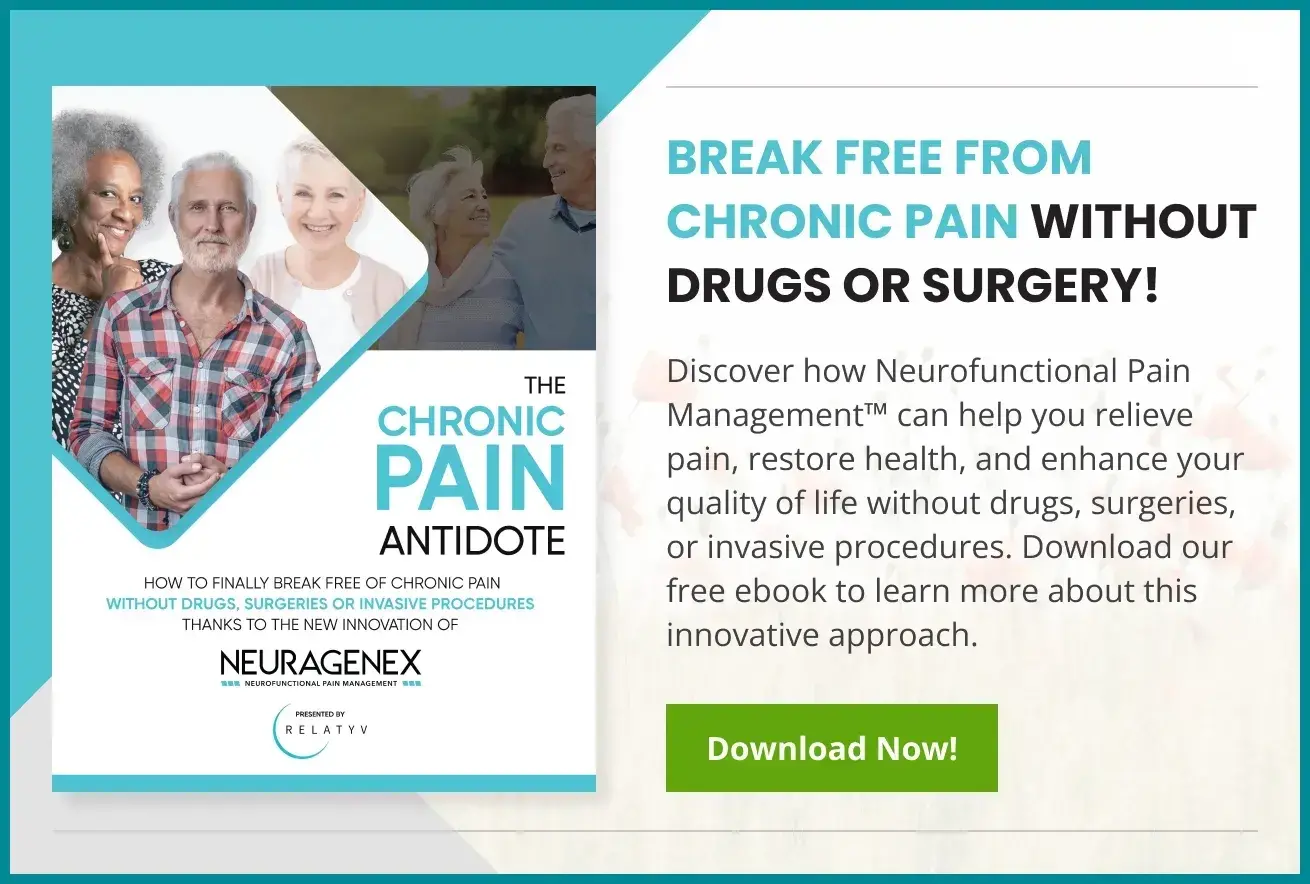Plantar Fasciitis

Does Plantar Fasciitis Cause Swelling?
Read More
October 6, 2023
Heel spurs and plantar fasciitis are two common culprits behind agonizing heel pain. If you’ve ever experienced heel pain, you know how it can seriously disrupt your daily life, making even simple activities like walking a challenge.
People frequently mix these two conditions, but it’s important to note that they do have some distinct differences. Understanding these differences enables you to promptly receive accurate treatment with the most effective pain management options.
In this article, we will explore the topic of heel spurs vs. plantar fasciitis, looking into their similarities and differences, as well as their common causes. We will also discuss Neurofunctional Pain Management as a non-pharmaceutical, non-surgical, and non-invasive solution for pain relief, focusing on the techniques used at Relatyv.
Before we look at the specific differences between heel spurs and plantar fasciitis, let’s briefly look at the heel’s anatomy so we can better understand the structures that are affected by these conditions.
The heel bone plays a vital role in stabilization as it is the foot’s most prominent bone, whereas the plantar fascia is a thick band of tissue that runs along the bottom of the foot, connecting the heel bone to the toes.
Having a solid understanding of this foot anatomy will help you understand the concepts we explore in the following sections about how the two disorders of heel spurs and plantar fasciitis impact this area.
Now, we can look closer at the specific characteristics of heel spurs and plantar fasciitis. The sections below explore how these conditions can uniquely impact your foot health, often leading to the pain and discomfort you may be experiencing.
Heel spurs are bony protrusions that grow on the underside of the heel bone. When there is ongoing inflammation and tension throughout the foot’s soft tissue, including the plantar fascia, it leads to heel spurs developing.
The bony growths can vary in shape and size and do not always cause pain. 38% of the population is estimated to have heel spurs, with many not even realizing it. However, when heel spurs become painful, it’s usually due to the irritation and inflammation of surrounding tissues.
On the other hand, plantar fasciitis is a condition causing significant inflammation throughout the thick plantar fascia tissue. This painful condition can cause individuals to experience stabbing or aching sensations at the base of the heel or along the bottom of the foot.
Plantar fasciitis occurs due to repetitive activities that subject the plantar fascia to excessive strain, leading to micro-tears and localized inflammation. These activities include repetitive running, dancing, and everyday movements like prolonged walking.
Understanding the unique nuances of these conditions can become a helpful guide for an accurate diagnosis and uncovering effective management strategies. Let’s explore why these two conditions often get mixed together.
While we’ve established that heel spurs and plantar fasciitis are two different conditions, they share some common features. To become more familiar with them, let’s look closely at the underlying causes and symptoms.
Both conditions often develop due to:
The symptoms for both conditions can include:
After exploring these similarities, you might be wondering how you can distinguish between the two conditions. Don’t worry just yet; the next section will clarify the best ways plantar fasciitis and heel spurs can be differentiated.
While their causes and symptoms can be similar, there are a few key differences to help you distinguish between heel spurs and plantar fasciitis.
Firstly, plantar fasciitis is one of the most common causes of heel pain, with an estimated 2 million people affected annually. This challenging condition can quickly become very painful, with pronounced heel discomfort, especially in the morning or after sitting still.
Relatyv uses Neurofunctional Pain Management (NFPM) techniques to provide an alternate approach to managing the pain associated with plantar fasciitis. Learn more about how we can help you here.
Heel spurs, on the other hand, are more likely to go unnoticed. In fact, less than 5% of people with heel spurs experience heel pain. Typically, they become an incidental finding during an X-ray or foot scan for an unrelated condition. While heel spurs are common among those with plantar fasciitis, they are rarely the source of pain. The good news is that you can often treat the pain without removing bony growths.
On the rare occasion that a heel spur is to blame for your heel discomfort, you may notice a distinct lump under the skin, and the jarring sensation tends to be confined to the heel area.
For an accurate diagnosis and proper treatment, schedule an appointment with your doctor for a clinical examination. Aside from examining the affected area, imaging may be recommended. An X-ray can confirm the presence of heel spurs, while an ultrasound may be used to reveal the inflammation associated with plantar fasciitis.
The following section will discuss practical ways to maintain your foot health and avoid unpleasant problems like plantar fasciitis.
It’s beneficial to focus on preventing heel pain and maintaining overall good foot health. Implementing the following strategies might help keep your feet pain-free:
If you or someone you care about is experiencing heel pain, it’s understandable that finding relief is a top priority. While simple preventive measures are excellent, it can be challenging to find relief once foot pain and discomfort have set in.
At Relatyv, we specialize in Neurofunctional Pain Management, which offers a revolutionary approach to pain relief without resorting to pharmaceuticals or surgery. Our innovative strategies effectively address the pain and inflammation causing your foot discomfort.
The advanced protocols at Relatyv focus on a whole-person method that utilizes a powerful combination of electroanalgesia and IV hydration therapy. Both are specifically designed to reduce pain and inflammation and promote healing.
Electroanalgesia is a unique therapy that directs high-frequency electronic waves to the affected area, reducing your body’s pain signals at a cellular level. This non-invasive method may also improve muscle function by increasing blood flow and decreasing inflammation.
Additionally, most people experience an enhanced sense of relaxation and well-being as the body’s natural endorphins elevate.
IV therapy directly administers critical nutrients, vitamins, and minerals to the body; these components assist anti-inflammatory processes, optimizing the body’s healing environment for tissue repair. At Relatyv, we customize each of our IV therapy programs based on individual needs to ensure patients receive the right nourishment for their healing journey.
Our professionals recognize that managing prolonged pain-related discomfort entails more than treating physical symptoms. This is why we provide lifestyle counseling that includes tailored guidance for improving your general physical health and well-being, including strategies for enhancing your foot health.
Simple daily tasks can become complicated when foot or heel pain is a persistent issue. Constant discomfort can take a toll on your physical and mental health and well-being.
Plantar fasciitis and heel bone spurs, two separate conditions, often share similar causes and symptoms. Most importantly, they both contribute to dreaded foot and heel pain. While plantar fasciitis is more prevalent, it is essential to receive an accurate diagnosis to initiate the proper treatment and help you find relief from the painful symptoms. Relatyv is a leader in the field of Neurofunctional Pain Management, offering non-pharmaceutical, non-surgical, and non-invasive solutions for easing the pain associated with common conditions impacting the feet.
With the insights gained from this article, you are now equipped with the fundamental knowledge, beneficial prevention strategies, and an understanding of advanced treatments that can help you find relief from unbearable foot pain.
About the Author
Will is a healthcare executive, innovator, entrepreneur, inventor, and writer with a wide range of experience in the medical field. Will has multiple degrees in a wide range of subjects that give depth to his capability as an entrepreneur and capacity to operate as an innovative healthcare executive.
Share on Social Media




You can see how this popup was set up in our step-by-step guide: https://wppopupmaker.com/guides/auto-opening-announcement-popups/
You can see how this popup was set up in our step-by-step guide: https://wppopupmaker.com/guides/auto-opening-announcement-popups/
Neurofunctional Pain Management Overview
Symptoms
Conditions Treated
Treatments
Articles by Category
Locations
Colorado
Wisconsin
Georgia
Hiram
Lawrenceville
Marietta
Powder Springs
Texas
Waco
Victoria
Illinois
Buffalo Grove
New Lenox
St. Charles
Arizona
Tucson
Waddell
Arlington
Avondale
Buckeye
Superior
Mesa
Palo Verde
Morristown
Tempe
Chandler
Anthem
Eloy
Florence
Fort McDowell
Phoenix
El Mirage
Coolidge
Gilbert
Arizona City
Casa Grande
Casa Blanca
Aguila
Sacaton
Apache Junction
Kearny
Stanfield
Goodyear
Litchfield Park
Alabama
Arkansas
California
Florida
Idaho
Indiana
Iowa
Kansas
Louisiana
Maryland
Michigan
Rhode Island
Minnesota
Mississippi
Nevada
New Jersey
New Mexico
North Carolina
Ohio
Pennsylvania
South Dakota
Tennessee
Utah
Virginia
Washington

